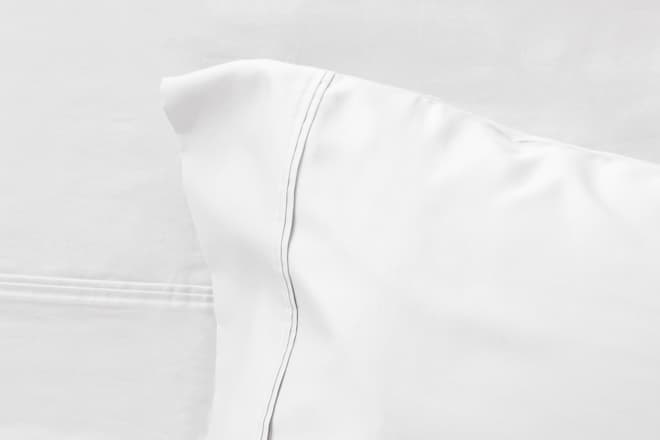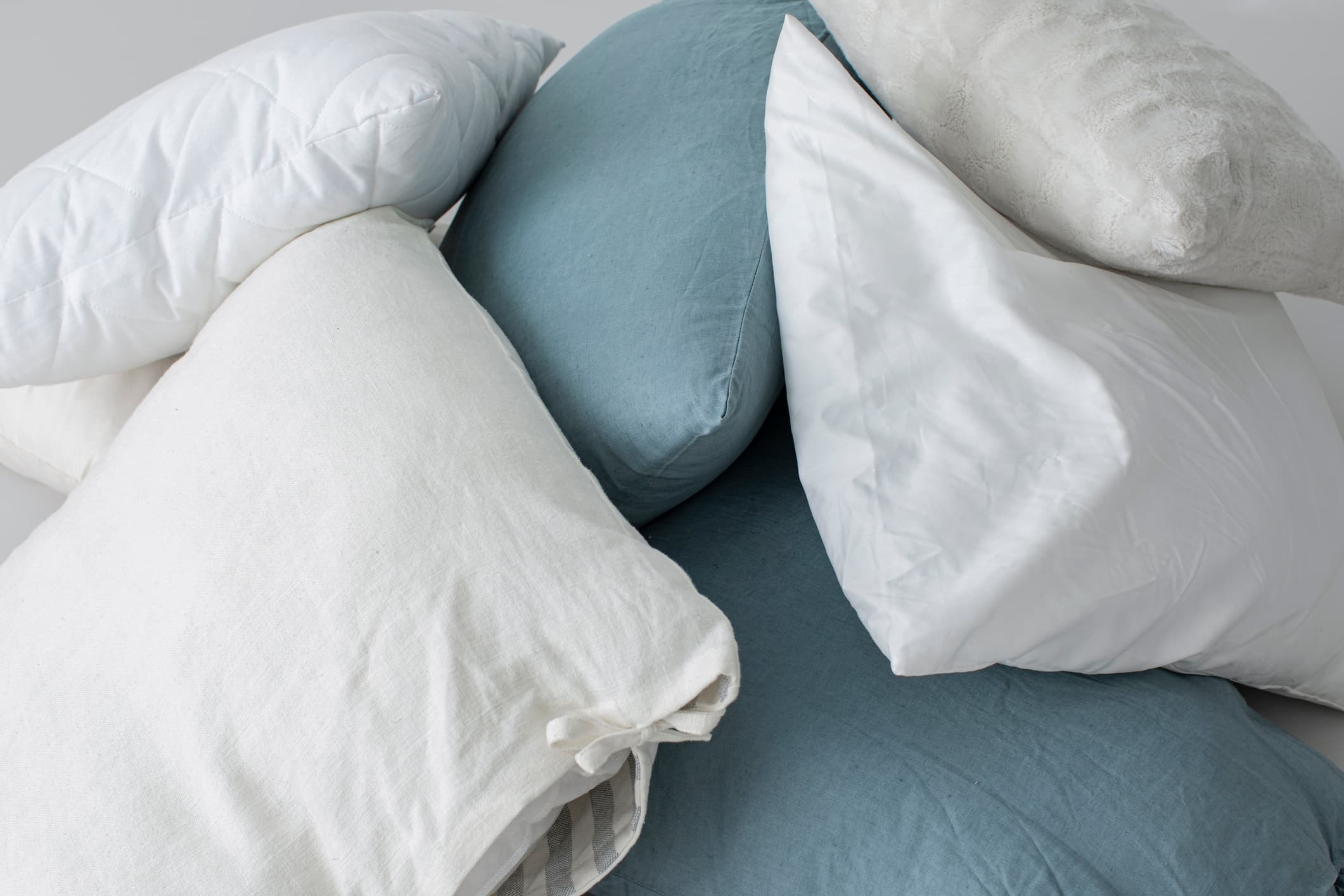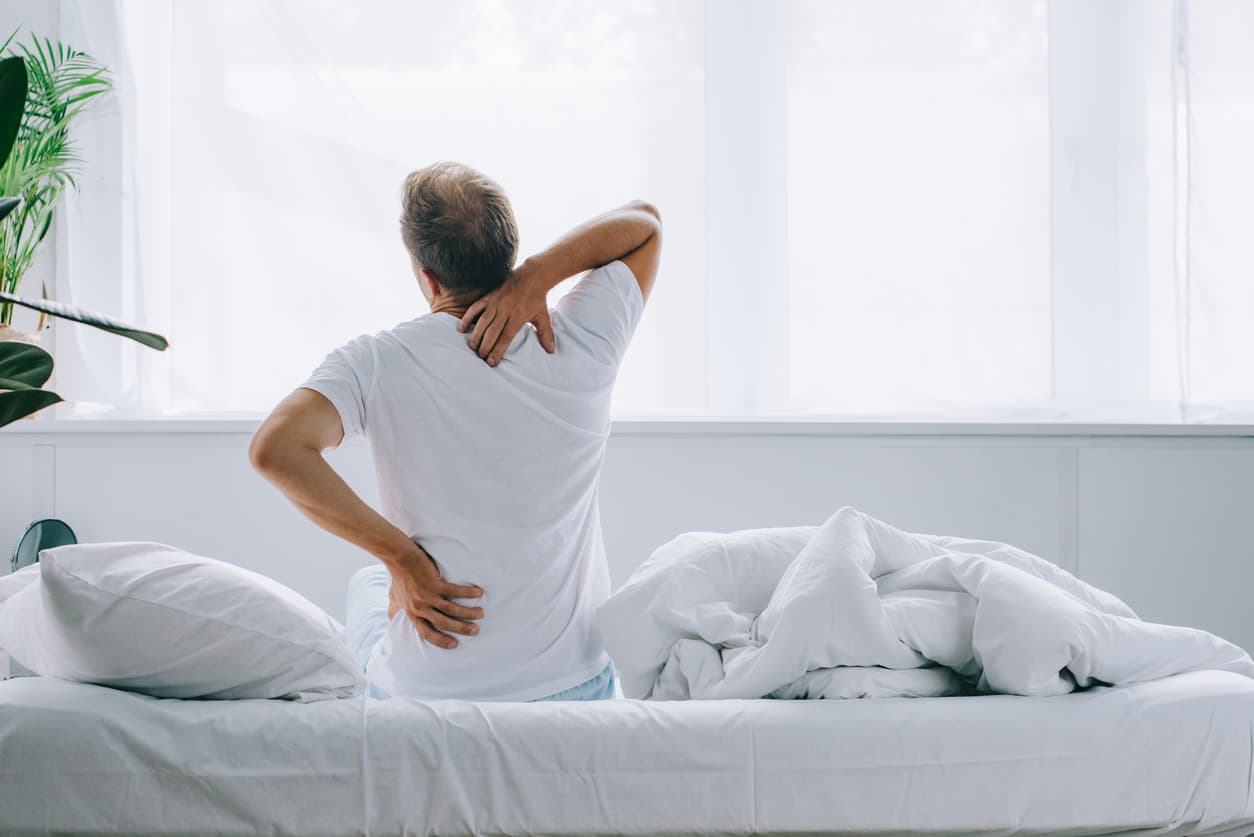There are two kinds of people when it comes to pillows. Some buy new pillows regularly; you see them buying stacks and stacks of fluffy new pillows and wonder what dignitary or celebrity must be visiting to warrant dropping such a large amount of cash on all those new pillows. But, then, some prefer—enjoy even—the same pillow they've had since 1987. However, knowing how to wash pillows can be a happy medium, keeping your pillows in peak condition for as long as possible.
Whether you have a pillow-buying problem or prefer your old faithful, we're sharing our best practices to keep your pillows looking fresh and feeling great on your Leesa mattress.
How Often Should You Wash Your Pillows?
Each week, you will spend approximately 56 hours on your pillow. No matter how clean your pillowcase is, it can be challenging to get it completely spotless. As you sleep, your body constantly sheds dead skin cells, which attract dust mites and their allergen-containing droppings. Consider these facts if you're scratching your head and wondering why you wash pillows.
A buildup of these substances can lead to dust mite allergy symptoms , such as asthma, rhinitis, and itchy eyes. As if this weren't bad enough, sweat, dribble, and facial oils can also soak your pillowcase. For this reason, we recommend you wash your pillows at least two times a year.
How to Wash Pillows in Your Washing Machine
Have you wondered: can pillows be washed in the washing machine? Or even, can pillows be washed at all? The washing machine is safe for some pillows but not for others.
Knowing how to wash pillows doesn't come naturally to all of us despite its importance. Follow the steps below to learn how to wash pillows in the washing machine safely.
Step 1: Check Your Pillow's Label
If you've wondered, "Can my pillow be washed?" the best place to start is always the pillow's label. We recommend that you consult the pillow's label for manufacturer-specific instructions, but if it has been a while since you cleaned them, keep reading to find out how to wash your pillows.
You might notice symbols on your pillow's label. For example, if you see a graphic with two numbers, the number inside the symbols represents the recommended washing temperature. The number on the bottom (outside the symbol) is the type of wash cycle recommended. For example, a 2 means a normal cycle, while a 6 means a gentle cycle is recommended.
Looking for new pillows instead of washing them? Relax in the comfort of cooling pillows, soft, breathable sheets, and more from Leesa. Shop Now

Step 2: Place Your Pillow in the Washing Machine
Before washing pillows, remove the pillow cover (if there is one) and ensure your washer is balanced by washing two pillows simultaneously. It is a common misconception that pillows should be washed on the machine's bulky cycle. This cycle should be reserved for heavy-duty items such as comforters. Instead, wash your pillow on your machine's gentle cycle to protect your pillow's structure.
Next, add a gentle, clear detergent and an optional 1/4 cup of bleach to your washing machine. Use only a tablespoon of detergent to prevent too many suds. Run the wash cycle at a warm temperature but avoid extra-high temperatures.
After the washing cycle, rinse your pillows and spin them dry. Using low or medium heat on a low-tumble setting would be best to help protect your pillow while drying. Due to varying models of dryers, the time it takes to dry your pillows may vary. If they are not fully dry, you may need to air dry the pillows partially until completely dry.
Step 3: Air Them Out
When you make your bed in the morning, take a second to fluff and reshape your pillows. This will help remove some dust, but daily fluffing isn't enough. At least once a month, on a bright and breezy day, hang them outside on a clothesline.
If you don't have access to this kind of space, you can run them through the dryer on air fluff or a no-heat cycle. Add a couple of tennis balls or dryer balls for extra fluffing power.
How To Wash Pillows: Other Types
Specialty pillows, such as down, feather, polyester, or memory foam pillows, may have different washing instructions. Before washing any pillow, always remove the protective cover over your pillow and wash it later.
Explore below to learn how to wash down pillows properly to prevent damage.
How to Wash Down or Feather Pillows
When washing down pillows, putting two pillows in your washer at a time may be helpful to balance the load. You could add a blanket or another pillow if you don't have two feather pillows. Wash your pillows in cold water only by following these steps:
1. Set your machine to the gentle cycle to protect the feathers of your down pillow.
2. Choose a mild detergent free from chemicals and fabric softeners. When washing down or feather pillows, choose a laundry detergent that does not sud too much. You won't need as much detergent as a normal load of laundry. This helps to prevent excess soap residue on your pillow and reduces the chances of feathers clumping together. If you suspect excess soap residue, run an extra rinse cycle to ensure all the soap is out of your pillows.
3. Place your pillows in the dryer on low to medium heat. You'll have to babysit them a bit and pull them out every 20 minutes to redistribute the filling and break up any clumps that may have formed. The safest way to dry down or feather pillows is by using the no-heat cycle. However, this can be a time commitment if you need your pillows dried quickly.
4. Enjoy your freshly washed and dried pillows!
How to Wash Polyester Pillows
Polyester pillows are less delicate than down or feather pillows. To wash polyester pillows, simply run them through a gentle cycle using regular detergent on a warm water wash. But, again, use only a little detergent. It will go a long way.
After washing, dry your polyester pillows on a dryer cycle that uses medium heat. You should also throw in some wool balls to keep your pillows extra fluffy. As always, it's recommended to read the label of your pillow before starting a wash or dry cycle.
How to Wash Memory Foam Pillows
When it comes to washing a memory foam pillow, it's important to note that completely immersing it in water (a.k.a. putting it in the washing machine) is not recommended.
Why can't you put a memory foam pillow in a washing machine? The machine's agitator will break up the structure of the foam. It may tear the material and can permanently damage it. Also, putting a memory foam pillow in the dryer is a fire hazard. Not to mention, the density of the foam will make it difficult for the pillow to fully dry.
If you need to wash the actual memory foam insert, use a vacuum attachment. This will get any dirt or dust that's deep in the pillow. We also recommend doing this for your mattress at least once every season.
When Should You Replace Your Pillows?
Even if you know how to wash pillows properly, it’s a good idea to replace them every two to three years.
As we mentioned, you may know someone who has had the same bed pillows for as long as you can remember. Because pillows collect allergens, dust mites, and, yes, dead skin cells (that's what makes pillows get heavier over time), some sleep and allergy specialists recommend purchasing new pillows every two to three years. However, purchasing an anti-allergy pillow cover can help extend the life of your pillow.
Another way to tell your pillow is ready to be tossed is to fold it in half. If you can fold your pillow in half and it doesn't spring back to its original supportive shape, it might be time to invest in a new one so your head and neck are properly supported.
How to Wash Pillows: FAQs
How often should I change my pillowcase?
You should change your pillowcase as often as you change your sheets, ideally about once a week. Like your sheets, your pillowcase catches drool, dirt, and dead skin cells, so if you're going to bed a little dirty or are a sweaty sleeper, you may want to change your sheets more often. Although we recommend putting a pillowcase on your Leesa pillows, if you prefer to sleep just on the cover, you should remove the cover and wash it about once a week.
How often should I clean throw pillows?
So many of the #bedgoals we see of Pinterest-worthy bedrooms feature layers of bedding and throw pillows that make you want to get in the bed and never get out. But what about cleaning them? Throw pillows are for decoration. So they don't need to be washed, right? Wrong.
Because we don't necessarily use them every day, we sometimes overlook throw pillows (and blankets). But think about all the times you toss your throw pillows on the floor, kick them under the bed, or lounge around on them during the day. As with bed pillows, check the laundry care tag to see if your throw pillows are machine washable. If not, you can vacuum them and spot-clean them as necessary.
How to wash pillows with baking soda?
Simply sprinkle a little baking soda on the pillow and let it sit for half an hour. Then vacuum the baking soda up.
How to wash pillows with yellow stains?
Most pillows can be spot treated with stain remover. When ready to wash, pour 1 cup of hydrogen peroxide and ½ cup of vinegar into the drum of your washer. Set the machine to soak. Once the soak cycle is done, add a gentle detergent and wash them on the gentle cycle.
How do you clean pillows without washing them?
A few options are available to help you keep your non-washable pillows clean and sanitary. You can sprinkle your pillows with baking soda and vacuum them after the baking soda has sat on them for 30 minutes or so.
You can spray your pillows with a light mist of white vinegar or soak a clean sponge in the vinegar and lightly wipe your pillow down. Leave it to dry for a few hours. Finally, air your pillows on a dry, breezy day, or place them in the dryer on a no-heat cycle.
How to wash pillows for deep cleaning?
If your pillow isn't machine washable, you can wash it by hand in your bathtub or a utility sink. Fill the basin with warm (not hot) water and add a few drops of your favorite laundry detergent (preferably odor-free). Once the tub is full, dunk the pillow and let it soak for 10 to 15 minutes. Once the pillow is done soaking, squish it by hand to get it nice and clean.
This will take about 10 minutes. Drain the tub and rinse the pillow until all the soap is gone. Next, dry the pillow by wrapping it in a dry bath towel, squeezing it nice and hard, and then placing it on a rack or hanging it outside to air dry. If your pillow is machine washable, add some baking soda to the mix and laundry detergent. Baking soda is excellent at removing odors and stains.
How often should you wash pillows?
We recommend cleaning pillows once a season or at least every four months.
How do you dry a pillow?
Many pillows that can be washed can also be dried. Here's how we recommend drying pillows:
- Place dryer balls in the dryer with the pillows. They will help the pillows dry and keep them from clumping up.
- Let them dry completely. Set your dryer on medium heat and check them every 15 minutes until they are completely dry.
- To completely air them out, you can also set them out in the sun until they're completely dry and so fresh they smell like a pocketful of sunshine. If you're not in a rush to have dry pillows, this method is safest to ensure your pillows remain in tip-top condition.
- If your pillows still need more fluffing, using the tennis ball method is one of the easiest ways to add fluffiness. Place a tennis ball in a sock, tie the sock at the end, and run your dryer with the pillow on a tumble dry low cycle for a few minutes. This method also works to reshape pillows after washing if you notice lumps in your pillow.
Don't have a dryer? You can still fix a lumpy pillow by reshaping it by hand and pushing the filling to the center of the pillow to remove bumps.
How to wash pillows with a blood stain?
After noticing blood stains on your pillow, address the stain as quickly as possible for the best results. To remove blood stains from a pillow, use baking soda and cold water in a 1:2 mix ratio. Leave the baking soda and water mixture to dry for a while (about 30 minutes), then rinse with cold water. Afterward, follow the normal steps on how to wash pillows.
you don't have baking soda handy, hydrogen peroxide can also help remove blood stains from a pillow. The ability to entirely remove blood stains from a pillow will depend on the type of pillow you have and the severity of the stain.
When should you replace your pillows?
Has your pillow lost its loft? Find out by folding your pillow in half. If it doesn't bounce back, it's time for a new one. If you need to replace your pillows, check out Leesa's extensive pillow collection.



